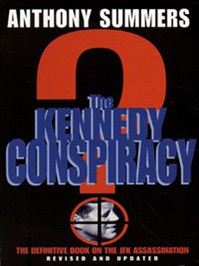 This week, I present one of the best general books on the assassination, The Kennedy Conspiracy by Anthony Summers. The title does not ‘reflect a set view by the author’ (p. ix). It remains open-minded about the lone assassin and about conspiracy theories. It rigorously hunts for the ‘true facts’ (p.361), and although it produces ‘no solutions’ (p.378), it is a readable, fascinating and commendable work. Originally published in 1980, in the aftermath of the House Select Committee on Assassinations (HSCA) investigation, it has been published under various titles over the years (Conspiracy, Not in Your Lifetime), and this is the ‘revised and updated’ third edition, published in 1998, the year the Assassination Records Review Board (ARRB) released its final report. (If you haven’t heard of the HSCA investigation and the ARRB trawl for documents, they took place because over the years the US citizenry believed less and less in the Warren Commission’s account of the assassination.)
This week, I present one of the best general books on the assassination, The Kennedy Conspiracy by Anthony Summers. The title does not ‘reflect a set view by the author’ (p. ix). It remains open-minded about the lone assassin and about conspiracy theories. It rigorously hunts for the ‘true facts’ (p.361), and although it produces ‘no solutions’ (p.378), it is a readable, fascinating and commendable work. Originally published in 1980, in the aftermath of the House Select Committee on Assassinations (HSCA) investigation, it has been published under various titles over the years (Conspiracy, Not in Your Lifetime), and this is the ‘revised and updated’ third edition, published in 1998, the year the Assassination Records Review Board (ARRB) released its final report. (If you haven’t heard of the HSCA investigation and the ARRB trawl for documents, they took place because over the years the US citizenry believed less and less in the Warren Commission’s account of the assassination.)
Summers’ book has two excellent chapters on the physical evidence of the assassination, evidence not mentioned in the ‘basics’ in last week’s blog entry so we’ll get to it this week, using Summers’ book. First let’s do the who and where.
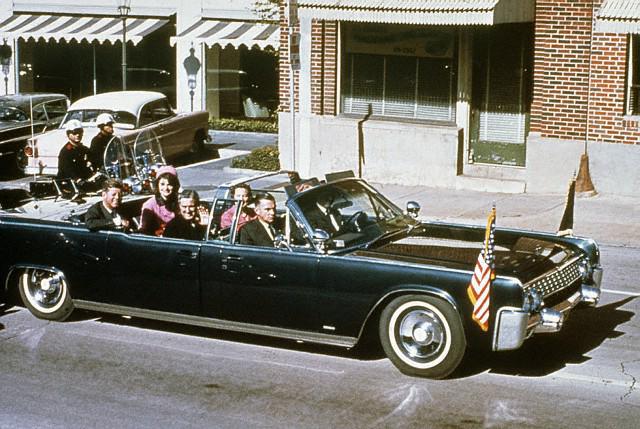
The car was a 1961 Lincoln Continental convertible. Riding in it with President JFK (b.1917) were his wife Jackie (1929-1994) in her now-historic pink Coco Chanel outfit, the Governor of Texas John Connally (1917-1993), his wife Nellie (1919-2006), and Secret Service agents Roy Kellerman (1915-1984) and William Greer (1909-1985). Greer drove.
The location in Dallas where the assassination took place is Dealey Plaza, which is a park where Main Street, Elm Street and Commerce Street come together to go under a railroad bridge, the so-called Triple Underpass. At the end of the silent home movie filmed by one of the crowd, clothing manufacturer Abraham Zapruder (1905-1970), the car disappears from view under this underpass. Moments before that Styx-like conclusion, Zapruder caught the assassination itself on film (frames). In the footage, the results of more than one bullet can be seen as the car drives along Elm Street. First JFK and Governor Connally are injured (no-one quite agrees on the moment(s) of impact), then (in frame 313) JFK is hit by a dramatic shot to the head and killed. Jackie climbs up onto the back of the car – trying to retrieve a bit of her husband’s skull, according to Secret Service agent Clint Hill (b.1932 and still alive), who ran up and jumped on, joining the car on its journey to the underpass and, eventually, Parkland Memorial Hospital.
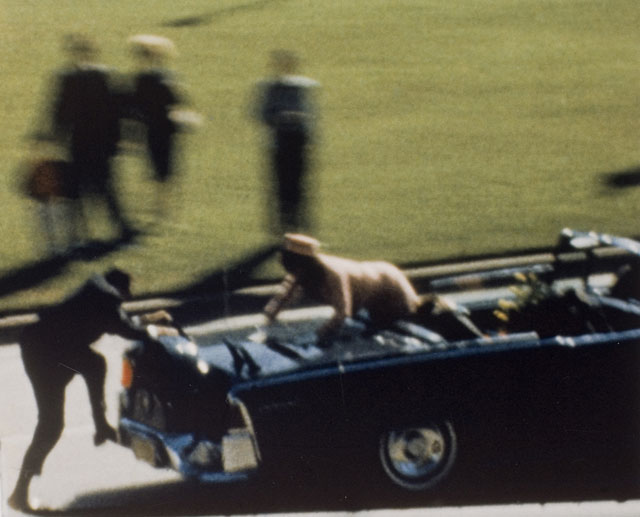
The physical evidence
Our first question is how many shots were there. Our second is where did the shots come from.
Most witnesses heard 3 shots. The HSCA did a survey and 132 out of 178 witnesses at the scene recalled 3 shots (Summers doesn’t mention it, but of the remainder some heard even less). There were 3 spent cartridges on the 6th floor of the Book Depository, which can’t explain why some witnesses recall hearing more. And what’s the sound of a shot, exactly? Summers notes that ‘a rifle shot actually makes three minutely separated sounds – the muzzle blast, the sound of a bullet breaking the sound barrier, and finally the impact on the target’ (p.19). Summers does a good job of reporting what the witnesses best placed to hear properly heard, and yes, some of them heard more than 3, Kellerman included.
Of the 178 surveyed, 49 recalled the shots coming from the Book Depository (behind the car) and 21 recalled shots from the Grassy Knoll (in front of the car).* The Grassy Knoll is described by Summers as ‘the whole area the President’s limousine passed after leaving the Book Depository to its rear… First there is a narrow slope topped by trees and bushes. Then comes a much longer slope up to a semicircular colonnade, with access steps and a retaining wall. Beyond that the slope continues behind the road, topped by more vegetation and a fence’ (p.23).
Blather update:
*Another description of the HSCA survey came to our attention, making out these figures of 49 and 21 to be 46 and 20, but a check of the relevant HSCA report (4034, p.140) confirms 49 and 21.
Police ran up the Knoll, as well as into the Book Depository. A gunman was seen in the 6th floor window, and there’s reason for suspicion that there was a gunman behind the fence on the Grassy Knoll too. Railroad workers saw smoke rising from the fence, and one of them, Lee Bowers (1925-1966), high up in a signal box, said he saw two men behind the fence, just before the shooting, then he saw ‘a flash of light or smoke or something’ (p.27). One witness, off-duty cop Tom Tilson, even said he saw a man come down the railroad embankment and get into a car (p.37). On the opposite side of the street to Zapruder stood Mary Moorman (b.1932 and still alive), who took a polaroid (detail) less than a second after the head shot that killed JFK. In this polaroid there is a shape behind the fence that is ‘no longer there in subsequent photographs’ (p.27 and Photo 5). I don’t see what others do in this image, and I suspect there might be something Rorschach about it. Perhaps the Moorman polaroid is something we should return to in this blog at a later date.
So, what did these 3+ shots do? Summers doesn’t go into the ‘first’ shot, which allegedly missed, and the book doesn’t mention James Tague, so we’ll have to return to that in another blog entry. The official story (both Warren & HSCA) is that there was a shot that missed.
Blather update:
The next two paragraphs were edited slightly after publication, to better describe Summers pp.29 & 32.
The next shot is the basis of the famed ‘single bullet theory’ and is known by many as ‘the magic bullet’. In order for there to be 3 shots, the first shot to hit JFK has to be the one that injured Connally too, which is apparently possible because Connally was in the correct alignment, in front of and below JFK. The Zapruder film seems to bear this out (watch frames 190-225) but it also seems far fetched. Experts perform tests on this from time to time and ‘suggest that such a phenomenon can occur’ (p.32), for what it’s worth. The ‘magic bullet’ was found to have been fired from the rifle found in the Book Depository, and in Dr. Vincent Guinn’s neutron activation tests for the HSCA, bullet fragments from Connally’s wrist were linked to the bullet (p.32).
The third (?) shot was the head shot. As the President famously falls back and to the left, it looks like he is shot from in front, not from behind. But while the HSCA thought there might indeed be a Grassy Knoll gunman, they thought he missed, because their evidence pointed towards a Book Depository shot, because the neutron activation tests linked the fragments in JFK’s brain to fragments found in the car, which were found to be fired from the Book Depository rifle (p.29). There are of course dissenters from Guinn, and Summers enumerates the various dissenters on pp.32-35, for those who want to get technical.
In the Bethesda autopsy of the President, the brain was not sectioned to identify the path of the ‘head shot’ bullet. The autopsy was so badly done that it doesn’t offer any evidence at all. The incomplete release of photos from the autopsy has led to confusion between the description of the wounds at Parkland and Bethesda, versus the autopsy photos, as I mentioned last week. As it happens, the photo of the ‘intact’ rear of the head was misleading. In fact, a hand is ‘pulling the scalp forward’ (p.13 and Photos 7 & 8).
Summers’ final words on the physical evidence are ‘Theories about the meaning of the physical evidence are just that – theories and speculation, an evidentiary quicksand that compels belief in neither a lone assassin nor a conspiracy’ (p.35).
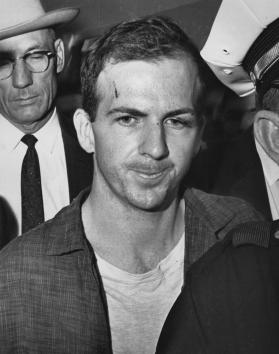
Ten things you love about Oswald
Faced with ‘quicksand’, much of the rest of The Kennedy Conspiracy deals with Lee Harvey Oswald as a possible clue to the truth. The man’s life was a mystery, though, as were the political circles he seemed to move in, and the way those touched upon Ruby’s circles and milieus, which involved people who definitely had it in for the Kennedy brothers. Briefly put, both Oswald and Ruby engaged in activities that brought them into contact with the nexus of anti-Castro Cuban exiles and their CIA and mafia helpers. This was the period of high activity following the Bay of Pigs Invasion (’61) and the Cuban Missile Crisis (’62). There are a lot of other interesting facts about Oswald. Here are ten.
1. Oswald was last seen 15 minutes before the assassination, having lunch on the 2nd floor of the Book Depository. He was next seen a minute and a half after it, once again in the lunch room.
2. Oswald’s print on the rifle found on the 6th floor was in ‘a place accessible only when the wooden stock was removed… the print had been impressed on the rifle when it was disassembled… it was an old print’ (p.54). It didn’t prove Oswald handled it on 22 November. As for the other gun, Oswald admitted owning the .38 he was arrested with, and cartridges found at the Tippit scene were linked to this gun. But 3 of the 4 bullets in Tippit’s body were of one make, and only 2 of the cartridges were of the same kind. This means there is both a missing bullet and a missing cartridge (p.69).
3. Oswald’s army file was not shown to the Warren Commission and was ‘routinely’ destroyed in 1973 (p.49), which is outrageous, and fuels speculation that he had been in Army Intelligence.
4. There was a pattern of Americans ‘re-defecting’ from the Soviet Union in 1959-60, so perhaps Oswald’s activities at that time were part of a larger scheme. One such re-defector was Robert Webster, ‘whose path criscrosses that of Oswald and Marina’ (pp.115,126-7). Marina was the Russian wife Oswald brought back to the US with him.
Before they left the USSR, the couple met Captain Alexis Davison in the US embassy in Moscow. Davison was the ‘contact man’ for Colonel Penkovsky, who spied for the West. In the investigation following the JFK assassination, Davison’s mother’s address was found in Oswald’s address book (pp.146-8). We might get a chance to return to Penkovsky in the future, when we deal with the Golitsyn/Nosenko issue.
5. George de Mohrenschildt (1911-1977) was a Russian emigré who took the returned Oswald under his wing in Texas from ’62 until de Mohrenschildt moved to Haiti in June ’63. He, his wife and Marina all seemed to think that it was Oswald who shot at the right-wing (Major) General Edwin Walker (1909-1993) in April ’63, a shooting at which the witness, Walter Coleman, claimed the involvement of two carloads of men. In 1977, de Mohrenschildt admitted he’d shared his suspicion of Oswald with CIA agent J. Walton Moore, which would mean the CIA had Oswald as a political assassination suspect 7 months before the JFK assassination (pp.167-8). The CIA didn’t share the information, which is embarrassing – or did they see Oswald as someone they could manipulate?
6. On the same day that Oswald applied for his entry papers for Mexico (17 September ’63), so did William Gaudet, who worked for the CIA. Summers interviewed Gaudet, who claimed to have known Oswald to see, and while he ‘balked at the idea that the CIA as an agency had any responsibility for the assassination, he thought there was a tie-in which would embarrass the CIA’ (p.256). No doubt this would have motivated the CIA to undertake a cover-up.
(Oswald’s trip to Mexico City is, to me, the most interesting part of the JFK assassination story, and I won’t go into it now, but I’ll definitely be returning to it.)
7. In New Orleans in the summer of ’63, Oswald spent time running his own one-man branch of the left-wing Fair Play for Cuba Committee (FPCC). It seemed he was undertaking a charade, to discredit the FPCC. Both the CIA and Army Intelligence were at this time infiltrating and discrediting the FPCC, but neither of them told the Warren Commission, and neither did the FBI (p.214).
8. FBI agent James Hosty (1924-2011) had investigated Oswald before the assassination. After it, he was told by his superior, Gordon Shanklin, to destroy a note* Oswald had left for Hosty,** as well as a letter Oswald wrote to the Russian embassy in Washington DC. Hosty destroyed the former but not the latter. And when the FBI typed a copy of Oswald’s address book for the Warren Commission, they left out Hosty’s details (pp.284-5, 445). Does all of this indicate FBI embarrassment that they didn’t stop the assassination, or does it indicate something else?
Blather updates:
*Allegedly. Shanklin denied this in testimony to Congress (Summers, p.285).
**Allegedly. Hosty said this note was not signed, and he only assumed it was from Oswald after he interviewed him in jail on 22 November (Hurt, Reasonable Doubt, p.253).
9. Stories of the the ‘second Oswald’ are mind-bendingly weird. They feel like the appearances of Indrid Cold in John Keel’s The Mothman Prophecies. Yet so many credible witnesses came across another man calling himself Lee Harvey Oswald, getting a rifle repaired and training with it, in September to November ’63. Bizarrely, the FBI were worried that someone was impersonating Oswald as far back as June 1960!* This concern was raised in an FBI document issued under the name of J. Edgar Hoover, no less. The document states that ‘there is a possibility that an imposter is using Oswald’s birth certificate’. Apparently when Oswald defected to the Soviet Union, the FBI were concerned about where the birth cert was (pp.288-302, 306-7). By the way, the second Oswald began appearing at least one day before the date of JFK’s Dallas visit-to-be was announced (it was announced on 26 September) (p.306).
Blather update:
*The explanation for this is given in a trawl through FBI files in John Newman, Oswald and the CIA (2008 edition), pp.143-4, 160, 213-4.
10. Oswald seems to have obtained his job as an order-filler in the Book Depository a month before the assassination quite by chance. There doesn’t seem to be anything more involved than neighbours chatting about jobs on the grapevine (p.282). He started working there on 16 October. How could Oswald have really been involved in an assassination plot before that date?
That concludes our flick through The Kennedy Conspiracy.
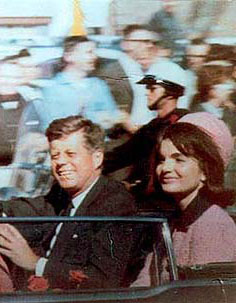
Esoteric bullet-in
Say the names of certain entities, and the JFK assassination is immediately brought to mind: Oswald, JFK, Jackie Kennedy, Jack Ruby, Tippit and many more. Think those names, think assassination. Note how the almost meaningless nomenclature ‘John and Jacqueline’ (John could signify John Connally as much as John Kennedy!) becomes assassination-related when it morphs into ‘JFK and Jackie’. There is also the fact that the ‘first couple’ (what a great phrase!) were known by the fairytale-ish names ‘Jack and Jackie’. This strongly influences one to think in terms of the masculine and feminine versions of the same being: anima-animus, magician-priestess, emperor-empress. Regardless of the real man and wife, the President and First Lady, these merely societal roles are insignificant on the level of archetype. On the deepest cultural level, in the Camelot icon-dream of the mass (media) unconscious, Jackie Kennedy was more than just some guy’s wife! But ‘Jackie Kennedy’ is an assassination-associated name as much as Oswald and Ruby, so she had to become ‘Jackie O’ for her ultimate goddess-apotheosis. It’s the zero-like, Omega-like ‘O’ that annihilates the previous level of existence.
The second murder, that of J.D. Tippit, tantalizes us with the ‘J’. What did ‘J.D.’ stand for? Apparently… absolutely nothing! He was named after a character in a story called ‘J.D. of the Mountains’ that his father read while out hunting (according to the biography on jdtippit.com). Perhaps it’s appropriate that the name with the fairytale-in-the-woods origin is parked away from the main scene in a place with the druidic title of Oak Cliff.
Ruby’s first name is a ‘J’ that stands for something, Jack in fact, which invites direct associations with the first couple, and this resonates in his mass-media death-pairing with Oswald (killer and killed together, the killed possibly also a killer), bringing the name ‘Jack’ into this, the third murder. Have we now three Jacks – and a Joker? Certainly Oswald has aspects of the Joker, the Jester, the Fool (with his ‘O’ like the Fool’s arcane number, zero), the paccio, the ‘patsy’ as he called himself shortly after his arrest. You can’t play Cluedo with Tarot cards, you know, so the Fool cannot have done it. Perhaps unconsciously we can never believe that the Fool-for-a-Day is a guilty man, when his true role is as the unwitting innocent, the sacrifice to be killed by our executioner – Ruby Jack we call him. ‘Jack’ in the sense of Jack the Ripper and Spring-heeled Jack: that kind of Jack.
- Who Shot JFK?
- The Kennedy Conspiracy
- Reasonable Doubt (part one)
- Reasonable Doubt (part two)
- Who’s Who in the JFK Assassination
- Deep Politics and the Death of JFK
- Deep Politics II: Oswald, Mexico, and Cuba (part one)
- Deep Politics II: Oswald, Mexico, and Cuba (part two)
- Oswald and the CIA (part one)
- Oswald and the CIA (part two)
- Marina and Ruth
- Oswald and the CIA (part three)
- Wilderness of Mirrors
- Perils of Dominance
- JFK and the Unspeakable
- Z-∞
